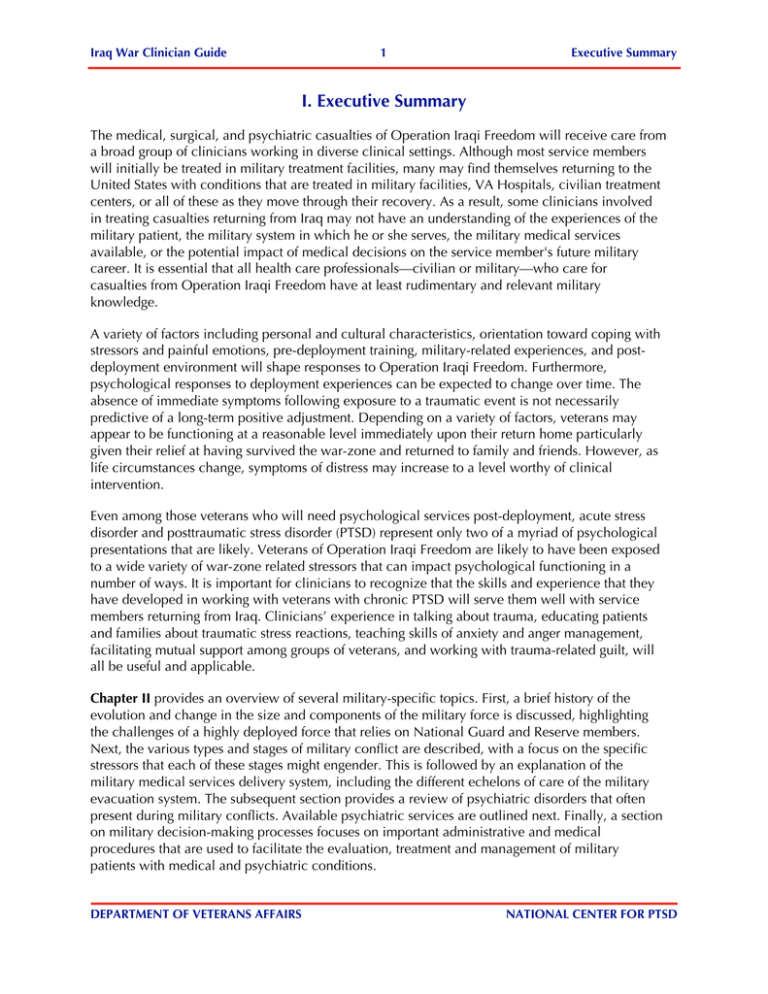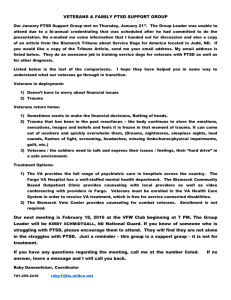
Iraq War Clinician Guide
1
Executive Summary
I. Executive Summary
The medical, surgical, and psychiatric casualties of Operation Iraqi Freedom will receive care from
a broad group of clinicians working in diverse clinical settings. Although most service members
will initially be treated in military treatment facilities, many may find themselves returning to the
United States with conditions that are treated in military facilities, VA Hospitals, civilian treatment
centers, or all of these as they move through their recovery. As a result, some clinicians involved
in treating casualties returning from Iraq may not have an understanding of the experiences of the
military patient, the military system in which he or she serves, the military medical services
available, or the potential impact of medical decisions on the service member's future military
career. It is essential that all health care professionals—civilian or military—who care for
casualties from Operation Iraqi Freedom have at least rudimentary and relevant military
knowledge.
A variety of factors including personal and cultural characteristics, orientation toward coping with
stressors and painful emotions, pre-deployment training, military-related experiences, and postdeployment environment will shape responses to Operation Iraqi Freedom. Furthermore,
psychological responses to deployment experiences can be expected to change over time. The
absence of immediate symptoms following exposure to a traumatic event is not necessarily
predictive of a long-term positive adjustment. Depending on a variety of factors, veterans may
appear to be functioning at a reasonable level immediately upon their return home particularly
given their relief at having survived the war-zone and returned to family and friends. However, as
life circumstances change, symptoms of distress may increase to a level worthy of clinical
intervention.
Even among those veterans who will need psychological services post-deployment, acute stress
disorder and posttraumatic stress disorder (PTSD) represent only two of a myriad of psychological
presentations that are likely. Veterans of Operation Iraqi Freedom are likely to have been exposed
to a wide variety of war-zone related stressors that can impact psychological functioning in a
number of ways. It is important for clinicians to recognize that the skills and experience that they
have developed in working with veterans with chronic PTSD will serve them well with service
members returning from Iraq. Clinicians’ experience in talking about trauma, educating patients
and families about traumatic stress reactions, teaching skills of anxiety and anger management,
facilitating mutual support among groups of veterans, and working with trauma-related guilt, will
all be useful and applicable.
Chapter II provides an overview of several military-specific topics. First, a brief history of the
evolution and change in the size and components of the military force is discussed, highlighting
the challenges of a highly deployed force that relies on National Guard and Reserve members.
Next, the various types and stages of military conflict are described, with a focus on the specific
stressors that each of these stages might engender. This is followed by an explanation of the
military medical services delivery system, including the different echelons of care of the military
evacuation system. The subsequent section provides a review of psychiatric disorders that often
present during military conflicts. Available psychiatric services are outlined next. Finally, a section
on military decision-making processes focuses on important administrative and medical
procedures that are used to facilitate the evaluation, treatment and management of military
patients with medical and psychiatric conditions.
DEPARTMENT OF VETERANS AFFAIRS
NATIONAL CENTER FOR PTSD
Iraq War Clinician Guide
2
Executive Summary
Chapter III provides information that is useful for addressing the following questions:
What are the features of the Iraq War that may significantly impact the quality of life, wellbeing, and mental health of returning veterans?
What are important areas of functioning to evaluate in returning veterans?
What might be beneficial for veterans of the Iraq War who request clinical services?
Chapter IV provides information about treatment of veterans recently evacuated due to combat or
war stress who are brought to the VA for mental health care, and Iraq War veterans seeking mental
health care at VA medical centers and Vet Centers. This chapter complements discussion of
special topics (e.g., treatment of medical casualties, identification and management of PTSD in the
primary care setting, issues in caring for veterans who have been sexually assaulted, traumatic
bereavement) that are addressed in other sections of this Guide. The authors highlight some
challenges for clinicians, discuss ways in which care of these veterans may differ from our usual
contexts of care, and direct attention to particular methods and materials that may be relevant to
the care of the veteran recently traumatized in war.
Chapters V-VII address medical issues. In Chapter V, the authors outline some considerations
related to the integration of mental health care with physical care of recently evacuated veterans of
Operation Iraqi Freedom. This kind of activity represents a challenge for VA mental health
professionals. Although VA PTSD, behavioral medicine, and other mental health practitioners are
familiar with delivery of traumatic stress assessment and treatment to help-seeking veterans with
chronic PTSD or general health problems, they are less likely to have delivered such services to
individuals who have been injured during very recent exposure to traumas of war. Chapter VI
focuses on the unique psychological needs of the amputee patient. The authors describe the
amputee population treated at Walter Reed Army Medical Center Psychiatry Consultation Liaison
Service and the therapeutic practices that have appeared to be most successfully implemented
there. Chapter VII provides information about PTSD for primary care providers, who may see an
increased number of veterans or active duty military personnel returning from the war. There also
may be increased contact with family members of active duty personnel, including family
members who have lost a loved one in the war or family members of individuals missing in action
or taken prisoner of war. In addition, there may be increased distress in veterans of other wars,
conflicts, and peacekeeping missions.
Chapter VIII discusses how clinicians treating trauma patients are at risk for emotional reactions
that, if left unattended, can lead to psychological stress, burnout, and reduction in clinical
efficiency and effectiveness. The authors recommend a combination of approaches that serve to
develop and sustain liaison relationships with all members of the treatment team.
Military sexual trauma refers to both sexual harassment and sexual assault that occurs in military
settings. Both men and women can experience military sexual trauma and the perpetrator can be
of the same or of the opposite gender. Chapter IX provides an overview of definitional issues and
epidemiology and discusses the types of psychological responses that are associated with military
sexual trauma. The authors also discuss screening, assessment, and treatment issues regarding
sexual assault and harassment.
Chapter X focuses on grief reactions. Although research into the prevalence and intensity of grief
symptoms in war veterans is limited, clinicians recognize the importance for veterans of grieving
DEPARTMENT OF VETERANS AFFAIRS
NATIONAL CENTER FOR PTSD
Iraq War Clinician Guide
3
Executive Summary
the loss of comrades. The existence of a distinct and intense set of grief symptoms indicates the
need for clinical attention to grief in the treatment plan.
Chapter XI proposes a simple process to screen individuals for substance abuse. The authors
suggest that care providers employ the screen in the three phases of pre-deployment, in the
combat zone, and upon evacuation. The data gained at each juncture will help the clinician’s
decision-making process in clarifying the contribution of substance use to a muddled clinical
picture, taking appropriate treatment steps, forestalling some unnecessary evacuations, and
prompting the best match between the individual’s needs and the military mission.
The frequency of deployment of military service members has increased in the past ten years.
Chapter XII addresses issues involving the families of military personnel. Clinicians need to be
aware of these issues when working with families of deployed soldiers in order to identify those
families that may need additional services.
Appendices provide a range of reference materials, including case studies, VA/DoD Practice
Guidelines for PTSD, published articles, and handouts for patients and their family members.
Although focused specifically on veterans of the war in Iraq, the material presented in this Guide
also applies to veterans of the war in Afghanistan or other recent warzone deployments.
Dedicated to the men and women who have served in
Operation Iraqi Freedom and Operation Enduring Freedom
DEPARTMENT OF VETERANS AFFAIRS
NATIONAL CENTER FOR PTSD






